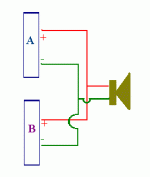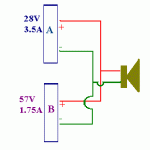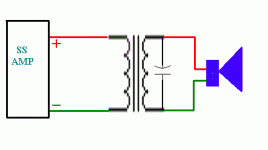Hello, I'd just like to ask a couple of elementary questions if I may.
An 8 ohm speaker rated at 500 watts is hooked up to two amps in parallel. In both cases, the amps are delivering the same program material.
A) In one case, amp A is 200 watts, the second amp is 20 watts. What happens when they both deliver full power? I mean to both amps and speaker.
B) Both amps are rated 100 watts. What happens to them and the speaker?
I'm interested if both amps are tube amps instead of solid state, would that change anything?
An 8 ohm speaker rated at 500 watts is hooked up to two amps in parallel. In both cases, the amps are delivering the same program material.
A) In one case, amp A is 200 watts, the second amp is 20 watts. What happens when they both deliver full power? I mean to both amps and speaker.
B) Both amps are rated 100 watts. What happens to them and the speaker?
I'm interested if both amps are tube amps instead of solid state, would that change anything?
Attachments
A) 







B) Assuming they are identical amplifiers that can even be paralleled, you won't gain anything. You will still have the same voltage swing on the outputs, but twice the current capability.








B) Assuming they are identical amplifiers that can even be paralleled, you won't gain anything. You will still have the same voltage swing on the outputs, but twice the current capability.
An externally hosted image should be here but it was not working when we last tested it.
Hi kelticwizard,
-Chris
The 20 W amplifier bocomes another load, a low resistance one. The excess voltage will dump into the lower supplies through the outputs or drivers (breaking down in reverse) or the flyback diodes.A) In one case, amp A is 200 watts, the second amp is 20 watts. What happens when they both deliver full power? I mean to both amps and speaker.
If the gains are identical, there will be some form of current sharing. If even so much as the phase shifts between them, one becomes an unhappy load. Excessive currents will flow.B) Both amps are rated 100 watts. What happens to them and the speaker?
Yes, if the amp is made to do this and the gains are the same, you change taps and the relatively high output resistance will current share. A tube amp with very high damping factor may have issues with this, or if the channels do not have the same gain (ie a fault with one side).I'm interested if both amps are tube amps instead of solid state, would that change anything?
-Chris
Hi Joe,
Many tube amps were set up to do that. Connect both together on the 16 R tap and connect an 8R speaker there also.

-Chris
Many tube amps were set up to do that. Connect both together on the 16 R tap and connect an 8R speaker there also.
More power!What would be the advantage of even trying it?

-Chris
Chris,
Wouldn't it be simpler just to use a higher powered amplifier? When one looks at the possible problems involved it just isn't logical to do it. What happens when/if one amplifiers lets out some magic smoke? Damage will result and this damage would be more extensive than it would be with just one amplifier in the mess. Well, there is driver damage also that more than likely will result. Call me cautious but I will opt for a larger amplifier every time but then again thats just me.
Wouldn't it be simpler just to use a higher powered amplifier? When one looks at the possible problems involved it just isn't logical to do it. What happens when/if one amplifiers lets out some magic smoke? Damage will result and this damage would be more extensive than it would be with just one amplifier in the mess. Well, there is driver damage also that more than likely will result. Call me cautious but I will opt for a larger amplifier every time but then again thats just me.
Hi Joe,
There was a time when high powered amps were terribly expensive and rare. The solution was to use a couple stereo units as mono units. I'm talking about the 50's and possibly early 60's. Not now.
-Chris
Absolutely!Wouldn't it be simpler just to use a higher powered amplifier?
There was a time when high powered amps were terribly expensive and rare. The solution was to use a couple stereo units as mono units. I'm talking about the 50's and possibly early 60's. Not now.
-Chris
A long time ago and before I new better...........
I once connected both channels of a Rotel integrated to a 12" driver. Both channels were fed identical signals. Worked OK at very very low volume.
I turned it up and the fuses blew everytime. Come to think of it, that Rotel was virtually indestructable.
Come on..... admit it...... I bet we've all done stupid things like this before we learnt the hard way?
I once connected both channels of a Rotel integrated to a 12" driver. Both channels were fed identical signals. Worked OK at very very low volume.
I turned it up and the fuses blew everytime. Come to think of it, that Rotel was virtually indestructable.
Come on..... admit it...... I bet we've all done stupid things like this before we learnt the hard way?

I would like to thank everyone for their clear answers.
Believe it or not, I was not after more power so much as something else. After all, there is little hearable difference between 100 watts and 120 watts.
Now, I would hope you would answer another question. I have a hunch the answer to this one is just as firm a No as the first, but I just want to make sure.
Both amps hooked up are 100 watts. However, one amp can deliver 28 V and 3.5 A, while the second delivers 57 V and 1.75 V.
I hook them both up as before, as I illustrate below.
Could this work?
Believe it or not, I was not after more power so much as something else. After all, there is little hearable difference between 100 watts and 120 watts.
Now, I would hope you would answer another question. I have a hunch the answer to this one is just as firm a No as the first, but I just want to make sure.
Both amps hooked up are 100 watts. However, one amp can deliver 28 V and 3.5 A, while the second delivers 57 V and 1.75 V.
I hook them both up as before, as I illustrate below.
Could this work?
Attachments
Hi kelticwizard,
What were you after?
No, as explained earlier in this thread.
Believe it or not, I was not after more power so much as something else
What were you after?
Could this work?
No, as explained earlier in this thread.
I was going to keep this secret, but if you are going to ask people questions and expect them to answer in good faith, you have to come clean yourself, so here goes.
I really wasn't after hooking two amps up, what I am trying to figure out is some way to hook an amp to an output transformer and have the amp drive the speaker for most of it's range, and have the output transformer drive the speaker in the bass range.
The output transformer would have a higher voltage and lower amperage than the speaker, so in the bass range where the speaker's impedance is high, more power can be delivered to it.
As a second choice, illustrated below, would be to have an output transformer with a network integral to it which gives higher voltage/lower impedance in the bass range. Haven't wuite worked out the details on that, (amateur, no tech training), but I do think a resonance network can be worked out.
The idea is to give a bass boost in the high impedance bass region of the speaker while leaving the rest of the frequency range pretty much alone.
All this is for a single voice coil speaker. I suspect a double voice coil speaker would present better possiblilites, but I want to work it out for a single voice coil speaker at this time.
I really wasn't after hooking two amps up, what I am trying to figure out is some way to hook an amp to an output transformer and have the amp drive the speaker for most of it's range, and have the output transformer drive the speaker in the bass range.
The output transformer would have a higher voltage and lower amperage than the speaker, so in the bass range where the speaker's impedance is high, more power can be delivered to it.
As a second choice, illustrated below, would be to have an output transformer with a network integral to it which gives higher voltage/lower impedance in the bass range. Haven't wuite worked out the details on that, (amateur, no tech training), but I do think a resonance network can be worked out.
The idea is to give a bass boost in the high impedance bass region of the speaker while leaving the rest of the frequency range pretty much alone.
All this is for a single voice coil speaker. I suspect a double voice coil speaker would present better possiblilites, but I want to work it out for a single voice coil speaker at this time.
Attachments
Hi kelticwizard,
The real problem in extending bass response is that the resonant frequency of the box / woofer is fixed. It forms an acoustic high pass filter. The response will fall quickly after that.
The only thing you will accomplish in driving the woofer harder at low frequencies will be to exceed it's maximum excursion. If you are lucky, it's just a "clack" as the voice coil strikes the back plate (flattening the rear of the former). The distortion will rise long before this.
The way I see it, your quest for more bottom end will best be answered physically. It's the box and speaker combination. Some boxes are better at extending the low frequency range than others. The speaker must have characteristics suitable for the box.
I think Dave and Cal could help you here better than I can for sure.
-Chris
The real problem in extending bass response is that the resonant frequency of the box / woofer is fixed. It forms an acoustic high pass filter. The response will fall quickly after that.
The only thing you will accomplish in driving the woofer harder at low frequencies will be to exceed it's maximum excursion. If you are lucky, it's just a "clack" as the voice coil strikes the back plate (flattening the rear of the former). The distortion will rise long before this.
The way I see it, your quest for more bottom end will best be answered physically. It's the box and speaker combination. Some boxes are better at extending the low frequency range than others. The speaker must have characteristics suitable for the box.
I think Dave and Cal could help you here better than I can for sure.
-Chris
anatech said:The only thing you will accomplish in driving the woofer harder at low frequencies will be to exceed it's maximum excursion. If you are lucky, it's just a "clack" as the voice coil strikes the back plate (flattening the rear of the former). The distortion will rise long before this.
-Chris
I disagree. If I had made the box bigger, the resonant frequency (closed box with Vb well under Vas) would be moved down and more power would then be delivered at the same frequencies which are now cut off with the smaller box. Of course, I would want the network to give a shape and amplitude commensurate with the rolloff of the box/speaker combo-not send it up to some 20 dB above midpoint or whatever.
As for distortion, I would like to try it and see.
Regardless of the driver and box behavior, it's wise to heed the advice of everyone regarding the interaction between the output stages of two different amps. If they're not intentionally identical or within the same feedback loop then don't expect anything less than sub-optimal results.
What you're trying to achieve is sort of an active crossover with two amps and a single driver. It would be better to try with two amps and two drivers
What you're trying to achieve is sort of an active crossover with two amps and a single driver. It would be better to try with two amps and two drivers
Thank you, BRWX.
The two amps bit was just to try to get a feel for what happens when two sources feed a single voice coil. Like I said, if I had my druthers, I druther have a transformer hooked up for the lowest octave and leads from the amp feeding it for the rest. Only as a second choice would I have the amp driving the single voice coil speaker throughout it's range, with a network boosting voltage and suppressing amperage the bottom octave. So I never really intended to hook up two amps, but am wondering about hooking up two sources-amp and transformer driven by the same amp.
But your cautions are well taken, and certainly should be stated for other diyers who might actually intend to hook up two amps to the same single voice coil driver.
The two amps bit was just to try to get a feel for what happens when two sources feed a single voice coil. Like I said, if I had my druthers, I druther have a transformer hooked up for the lowest octave and leads from the amp feeding it for the rest. Only as a second choice would I have the amp driving the single voice coil speaker throughout it's range, with a network boosting voltage and suppressing amperage the bottom octave. So I never really intended to hook up two amps, but am wondering about hooking up two sources-amp and transformer driven by the same amp.
But your cautions are well taken, and certainly should be stated for other diyers who might actually intend to hook up two amps to the same single voice coil driver.
- Status
- This old topic is closed. If you want to reopen this topic, contact a moderator using the "Report Post" button.
- Home
- General Interest
- Everything Else
- Two Amps Powering One Driver


